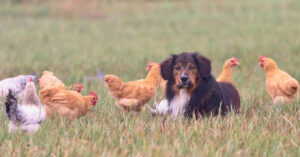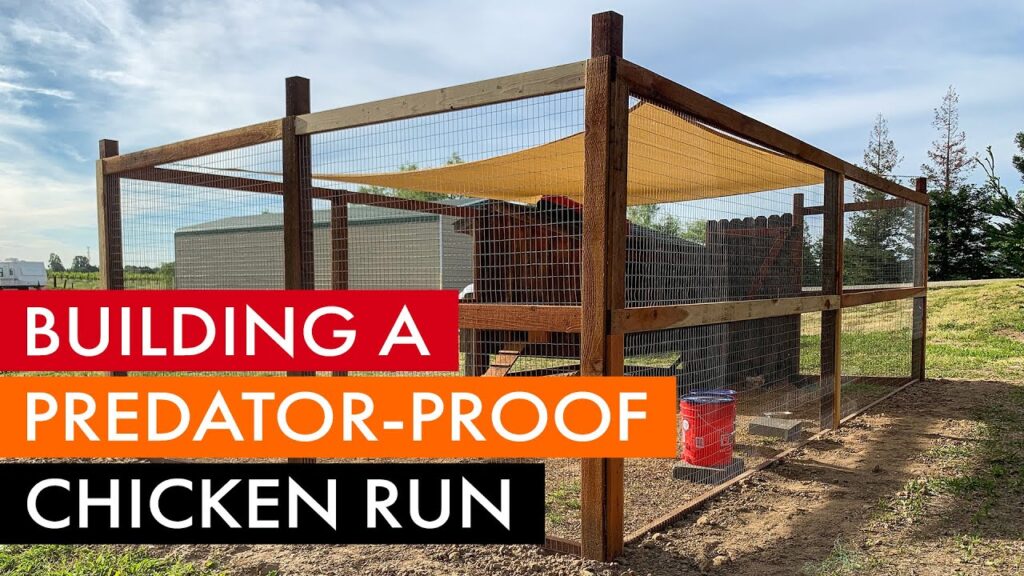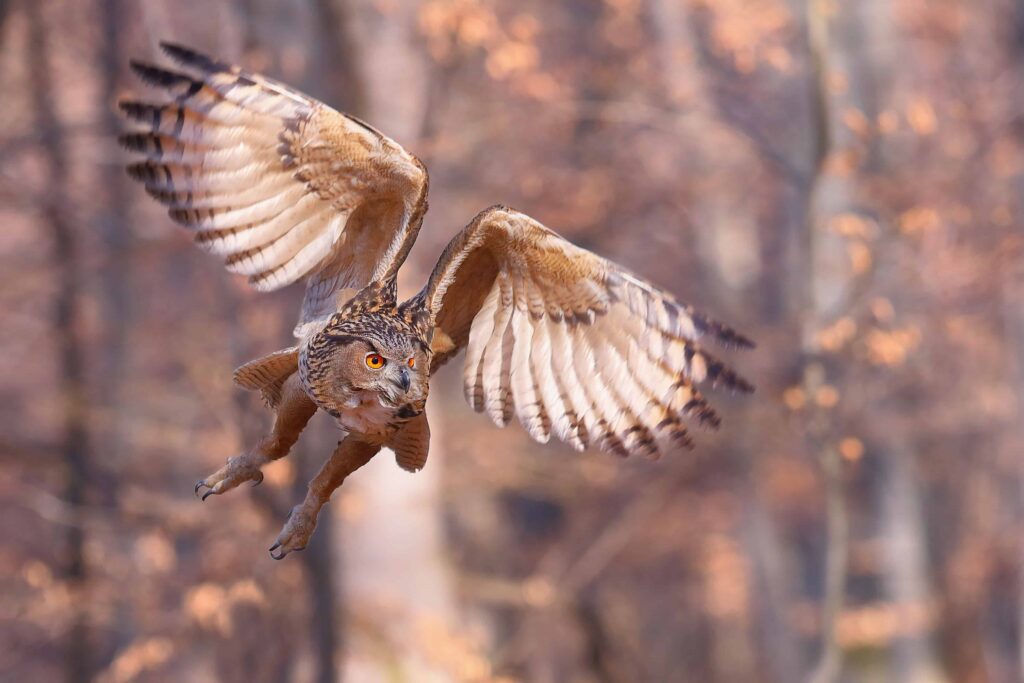Last updated on August 6, 2025
In just 5 minutes, you’ll know which guardian animal fits your flock, your budget, and your property. Imagine a vigilant protector watching over your flock, a natural deterrent that keeps predators at bay day and night. So, what is the best animal to protect chickens? The honest answer is: it depends entirely on your specific situation.
As a poultry farmer who has managed predators for years, I’ve seen firsthand what works and what doesn’t. This guide offers practical advice to help you safeguard your flock.
To quickly find your best option, consider this decision helper:
Guardian Animal Decision:
- What’s your primary predator threat?
- Large, persistent predators (coyotes, bears, wild dogs)? Go to Step 2.
- Smaller predators (foxes, weasels) or aerial threats (hawks, owls)? Go to Step 3.
- For Large Predators (LGDs, Donkeys, Llamas):
- Do you have significant acreage (1+ acre) and are prepared for a high commitment (training, cost, barking)?
- YES: A Livestock Guardian Dog (LGD) is your best physical protector.
- NO: Consider a donkey or llama for balanced, lower-maintenance protection against canids, especially if you have pasture.
- Do you have significant acreage (1+ acre) and are prepared for a high commitment (training, cost, barking)?
- For Smaller/Aerial Predators (Geese, Llamas):
- Do you need primarily an alarm system and have a water source?
- YES: A guard goose is an excellent, low-cost alarm.
- NO: A llama can also serve as an alert system and physical deterrent for smaller threats.
- Do you need primarily an alarm system and have a water source?
This guide helps you determine which is right for your farm.
The golden rule is crucial: no guardian animal replaces a secure coop. They are a powerful layer of defense, not the entire defense system. A predator-proof coop is still your number one priority for protecting chickens from predators. For detailed steps on making your coop impenetrable, see our guide on DIY Predator Proof Your Chicken Coop.
The Critical Distinction: Guard Dog vs. Guardian Animal
Understanding the difference between a guard dog and a guardian animal is fundamental. This clarifies a common misunderstanding among poultry keepers.
What is a Guard Dog?
A guard dog protects human territory, like a house or yard. They are territorial and suspicious of strangers, both animal and human.
Often trained to be aggressive, these dogs are generally not suitable for living with livestock, as their instincts might lead them to harm the very animals they’re supposed to protect.
What is a Guardian Animal?
A guardian animal protects livestock, such as chickens, goats, or sheep. They bond with the flock and have a low prey drive towards them.
They are defensive rather than aggressive towards predators, working independently to deter threats. This is the category we focus on for chicken protection.
The Gold Standard: Livestock Guardian Dogs (LGDs)
Livestock Guardian Dogs (LGDs) are often the top choice for serious predator control. This section offers a realistic look at these dedicated protectors.
Are Guardian Dogs Effective? The Power of the LGD
LGDs effectively deter predators with their constant presence, scent marking, and intimidating bark. They confront predators like foxes, coyotes, and wild dogs. As Texas A&M AgriLife notes, “Guardian dogs reduce predation in three major ways: 1) territorial exclusion, 2) disruption, and 3) confrontation.” (Source: Texas A&M AgriLife Research and Extension Center) Studies confirm significant success; for instance, a long-term study in Namibia found that 73% of farmers reported a large decline in livestock losses after acquiring an LGD. (Source: Journal of Range Management)
Their main goal is to protect their bonded flock, making them a formidable living barrier against common threats. For more on protecting against specific canine predators, see our guide on Protecting Chickens from Foxes, Coyotes & Wild Dogs. An LGD’s effectiveness depends heavily on the predator pressure in your area and the acreage they need to patrol.
The Best Livestock Guardian Dog Breeds
When considering what is the best breed of dog to protect livestock, a few stand out:
- Great Pyrenees: This classic choice is known for being calm and good with families. They are also known for barking, especially at night, and having a tendency to roam if not properly fenced.
- Anatolian Shepherd: More athletic and assertive than the Pyrenees, Anatolians work well for larger areas with higher predator pressure from coyotes or wild dogs. They are very protective and independent.
- Maremma Sheepdog: Similar to the Pyrenees in temperament, Maremmas often bond more with their flock and less with people. They are vigilant and hardy.
The Reality Check: What You MUST Know Before Getting an LGD
Being brutally honest about the challenges of LGDs is vital for anyone considering one:
- The Barking: They bark all night, every night. It is their job to alert and deter predators. If you have neighbors within half a mile, you will likely get noise complaints. This isn’t a flaw; it’s a core feature of their guarding instinct. I’ve had neighbors ask about the constant barking, and it’s something you have to manage and explain. The commitment level for managing barking is high.
- The Roaming: LGDs have a strong sense of territory and will patrol it, often covering large distances. World-class fencing is non-negotiable to keep them contained and effective. I once had an LGD find a weak spot in my perimeter fence and patrol a neighbor’s field for hours before I could retrieve him. This emphasizes the need for secure acreage.
- The Training: They are not “plug and play” pets. LGDs require extensive training and socialization from puppyhood to bond correctly with the flock and learn not to harm them. My first LGD, a Great Pyrenees named Gus, went through a “testing phase” at 10 months old where he started chasing the chickens for fun. It took two weeks of consistent correction and tethering him near me to teach him that the flock was his family, not his toys. Training is never truly “done.” As the Ontario Ministry of Agriculture notes, “Young LGDs do not become fully effective until they are about 2 years old,” highlighting the long-term nature of their development and the commitment level required. This addresses how to stop LGD from chasing goats/chickens?
- The Cost: The initial purchase price, plus ongoing vet bills and food for a giant breed dog, represents a significant financial and time commitment. They are a long-term investment. This is a major factor in the overall commitment level.
Is an LGD Right for You? A Quick Checklist
Before committing to a Livestock Guardian Dog, honestly answer these questions:
- Do you have at least one acre of securely fenced land? (Y/N)
- Are your closest neighbors more than a quarter-mile away? (Y/N)
- Is your budget prepared for $100+/month in food and vet bills for a giant dog? (Y/N)
- Do you have the time to commit to 18-24 months of consistent training? (Y/N)
If you answered “No” to any of these, an LGD is likely not a good fit for your situation, regardless of predator pressure or acreage.
What to Ask a Breeder/Seller for an LGD
When looking for an LGD puppy, asking the right questions is crucial to ensure you get a dog with the right instincts and upbringing:
- Are the parents working LGDs on-site? Can I see them with their livestock?
- Have the puppies been raised with poultry from birth?
- What health testing has been done on the parents (e.g., hip dysplasia, elbow dysplasia)?
- What is your philosophy on early socialization and training for LGD puppies?
- What kind of support do you offer after the sale?
LGD Management
- Do livestock guardian dogs sleep outside? Yes, they must live and sleep with the flock they are protecting to be effective. This constant presence builds their bond and allows them to be on duty 24/7.
- Do livestock guardian dogs need to be walked? No. They self-exercise by patrolling their territory. A traditional “walk” can confuse their sense of territory and distract them from their guarding duties.
The Alarm System: Using Geese as Guardians
Geese can be a valuable addition to your flock’s security, primarily as an effective alarm system.
Can Geese Be Used as Guard Dogs?
Yes, geese serve as an alarm system. Their loud, aggressive honking effectively alerts you (and the flock) to danger. They raise a commotion at the sight of foxes, coyotes, or other perceived threats. As A-Z-Animals.com notes, “Geese are incredibly watchful animals, making them excellent natural guardians. They have exceptional eyesight and can see ultraviolet light and finer detail than many mammals.” (Source: A-Z-Animals.com) They are particularly useful for alerting to aerial threats like hawks and owls; learn more in our guide on Protecting Chickens from Hawks and Owls. This is a low commitment level option for predator pressure from smaller threats.
Best Goose Breeds for Guard Duty
- African Geese & Chinese Geese: These are often the top choices for guard duty because they are among the loudest and most naturally assertive breeds. Their vocal nature makes them excellent watchdogs.
The Downside of Geese
While great alarms, geese come with their own set of challenges:
- Aggression: Geese can be aggressive towards chickens (especially roosters), sometimes injuring them. A protective gander can and will attack small children, visitors, and even you during mating season. I once had a gander named “Honker” who would charge anyone who came near his flock during nesting season, leaving painful bruises. As wildlife biologist Vanessa A. Williams explains, “Geese are typically only defensive when they have a nest they’re protecting or are defending their young.” (Source: Popular Science) They require careful management and respect for their territorial nature, increasing the commitment level.
- Water Needs: They need a consistent water source for swimming and cleaning, which can get messy and require frequent cleaning to prevent disease. I quickly learned that dedicated goose pools need daily attention to keep the coop area from becoming a muddy, unsanitary mess.
- Mess: Geese produce a lot of droppings, which can make their living area muddy and unsanitary if not managed well.
The Unexpected Guardians: Donkeys and Llamas
Donkeys and llamas offer unique advantages as guardian animals, especially for those with larger properties or specific predator challenges.
Donkeys: The Canine Haters
Donkeys have a natural, instinctual aggression towards canids like foxes, coyotes, and wild dogs. They will often chase, kick, and even stomp these predators.
A standard-sized donkey is required for effective guarding; miniature donkeys are typically pets and not effective guardians. Their suitability depends on your predator pressure and available acreage.
Llamas: The Calm Sentinels
Llamas are alert, curious, and will charge and stomp predators they perceive as a threat. They are generally calmer and less aggressive than donkeys, making them a good fit for some farms. The California Department of Food and Agriculture notes, “Llamas instinctively dislike canines. Llamas’ responses to predators include: becoming alert, alarm calling, walking to or running toward the predator; chasing, kicking, or pawing the predator, or positioning themselves between the sheep and the predator.” (Source: California Department of Food and Agriculture)
Llama vs. Donkey for Protection: Which is Right for You?
This table compares these two unique guardian animals to help you decide:
| Feature | Donkey | Llama |
|---|---|---|
| Best Against | Canids (Foxes, Coyotes, Wild Dogs) | Canids, some climbing predators |
| Temperament | Can be aggressive, loud | Generally calmer, more aloof |
| Fencing Needs | Respects standard fences | Can be prone to jumping |
| Care Level | Lower (hardy, less grooming) | Higher (shearing, more sensitive to heat) |
| Herd Size | Best kept singly for guarding | Can work singly or in pairs |
Note: A “donkey llama hybrid” is not a real or viable option for a guardian animal. These are distinct species.
The Downside of Donkeys and Llamas
Even these seemingly gentle giants have their drawbacks:
- Accidental Harm: While effective against predators, donkeys can be overly aggressive and may accidentally kick or stomp chickens, especially if not raised with them carefully from a young age. I’ve heard stories of new donkeys accidentally injuring chickens during their initial adjustment period. It’s crucial they are introduced slowly and observed closely. As DonkeyRescue.org states, “While donkeys are commonly used as livestock guardians due to their natural instincts to defend their territory against potential threats, there are many reasons we do not recommend donkeys being used in these circumstances and why they are not usually the best choice.” (Source: DonkeyRescue.org)
- Loudness (Donkeys): Donkeys can be incredibly loud, braying frequently, which can be a nuisance for neighbors. I’ve certainly had my donkeys bray at the most inconvenient times, reminding me that while they’re great guardians, they’re not always quiet companions.
- Specific Care: Llamas require shearing annually and can be more sensitive to extreme heat than donkeys. Both need appropriate pasture and shelter. These factors contribute to their overall commitment level.
Realistic Cost Breakdown for Guardian Animals
Understanding the financial commitment is crucial before bringing a guardian animal onto your farm. Here’s an estimated cost breakdown:
| Animal | Upfront Cost | Annual Feed/Vet Cost (Est.) |
|---|---|---|
| LGD Puppy | $800 – $2,500+ | $1,200 – $2,000+ |
| Donkey | $500 – $1,500 | $500 – $800 |
| Guard Goose | $10 – $25 (for a gosling) | $100 – $200 |
Note: These are estimates and can vary widely based on location, breeder reputation, animal health, and specific feed costs.
Final Verdict: What is the Best Animal for Herd Protection?
The “best” animal depends on your specific situation. Use this summary to help make your decision:
| Animal | Primary Role | Best For | Commitment Level |
|---|---|---|---|
| LGD (Dog) | Physical Fighter & Alarm | High predator pressure (bears, coyotes) | Very High |
| Donkey | Physical Fighter | Medium predator pressure (foxes, coyotes) | Medium |
| Llama | Physical Fighter & Alarm | Medium predator pressure (foxes, coyotes) | Medium |
| Goose | Alarm System | Low predator pressure (hawks, weasels) | Low |
Quick FAQs on Which Guardian Animal is Best for Your Chickens?
Can I use multiple guardian animals together?
Yes, but careful introduction and monitoring are essential, especially with different species, to ensure they bond with the flock and not just each other.
Are guardian animals safe for children?
LGDs can be good with respectful children if properly socialized. Geese and donkeys can be aggressive, so supervision is crucial, especially with young children.
How long does it take for a guardian animal to be effective?
LGDs can take 18-24 months to mature. Geese, donkeys, and llamas can show guarding instincts much sooner, often within weeks or months of bonding.
Do guardian animals need special food?
LGDs require high-quality large-breed dog food. Geese, donkeys, and llamas can often forage much of their diet but may need supplements or hay.
Conclusion
Choosing the best animal to protect chickens is a personal decision based on your specific predators, property size, and personal commitment. An LGD is the ultimate protector but also the biggest responsibility. A goose is a simple alarm system. Donkeys and llamas are a great middle ground for many farms.
Remember, the most important step you can take is securing your coop. A guardian animal is your flock’s vigilant partner, but a strong physical barrier is their last line of defense. For more comprehensive guides on coop security and predator management, explore our articles on Raccoon-Proof Chicken Coops and Chicken Predators & Protection.
Do you use a guardian animal for your flock? Share your experiences—the good and the bad—in the comments below!


